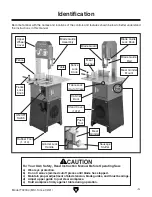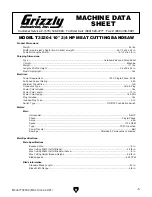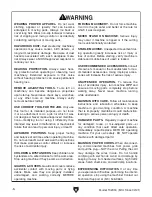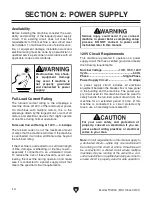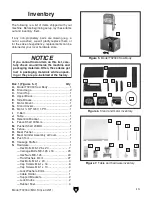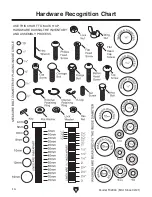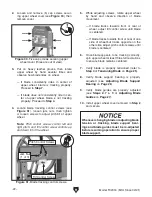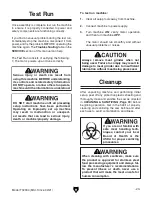
Serious cuts, amputation, or death can occur from contact with the moving saw blade during
operation or if blade breakage occurs. To reduce this risk, anyone operating this machine
MUST completely heed the hazards and warnings below.
CLEANING & SANITIZING. Keep machine and
work area clean and sanitary using solutions
approved for food processing by the USDA. DO
NOT use solvents that can contaminate meat and
cause illness. Properly clean and sanitize saw
before and after each use.
BLADE REPLACEMENT. Under normal condi-
tions, saw blade should be replaced after cutting
approximately 4400 lbs. of meat or bone. To avoid
mishaps that could result in operator injury, make
sure blade teeth face down toward table and
blade is properly tensioned and tracked before
operating.
SUPPORTING CUTS. Cuts should always be
fully supported by table, fence, and included meat
pusher. If necessary to maintain safe cuts, use
auxiliary fixtures. Do not cut very small or thin
pieces that are hard to control.
CUTTING TECHNIQUES. To avoid blade get-
ting pulled off wheels or accidentally breaking
and striking operator, always turn saw
OFF and
wait for blade to come to a complete stop before
backing workpiece out of blade. DO NOT back
workpiece away from blade while saw is running.
DO NOT force or twist blade while cutting. This
could result in blade damage or breakage.
WORKPIECE MATERIAL. This machine is
designed to cut fresh and frozen meat and bones.
This machine is NOT designed to cut wood,
metal, glass, stone, tile, etc.
HAND PLACEMENT. Placing hands or fingers
in line with blade during operation may result in
serious injury if hands slip or workpiece moves
unexpectedly. Do not position fingers or hands in
line with blade, and never reach under table while
blade is moving.
BLADE SPEED. Cutting workpiece before blade is
at full speed could cause blade to grab workpiece
and pull hands into blade. Allow blade to reach full
speed before starting cut. DO NOT start machine
with workpiece contacting blade.
FEED RATE. To avoid risk of workpiece slipping
and causing operator injury, always feed stock
evenly and smoothly.
BLADE CONDITION. Dull blades require more
effort to perform cut, increasing risk of accidents.
Do not operate with dirty, dull, cracked or badly
worn blades. Inspect blades for cracks and miss-
ing teeth before each use. Always maintain proper
blade tension and tracking while operating.
CLEARING JAMS AND CUTOFFS. Always stop
saw and disconnect power BEFORE clearing
scrap pieces that get stuck between blade and
table. Use brush or push stick, not hands, to clean
scraps from table.
BLADE CONTROL. To avoid risk of injury due to
blade contact, always allow blade to stop on its
own. DO NOT try to stop or slow blade with your
hand or the workpiece.
Model T32304 (Mfd. Since 02/21)
-9-
Additional Safety for Meat Saws
Summary of Contents for T32304
Page 52: ......





